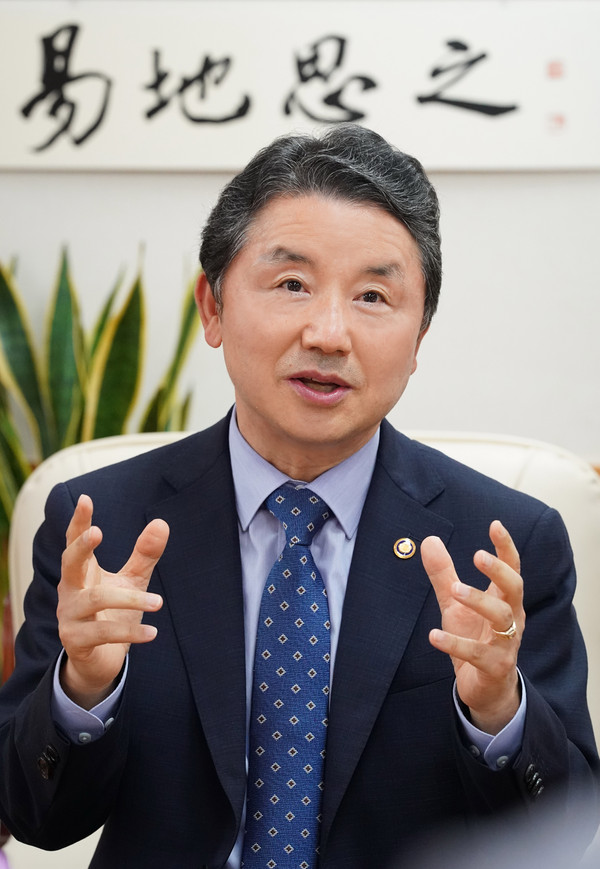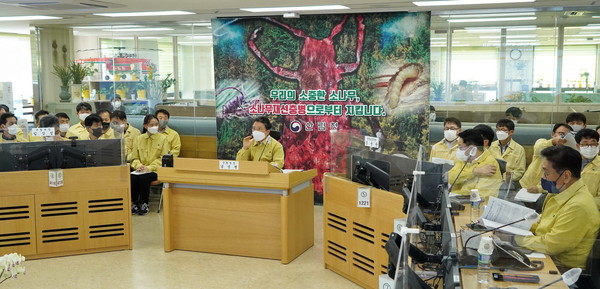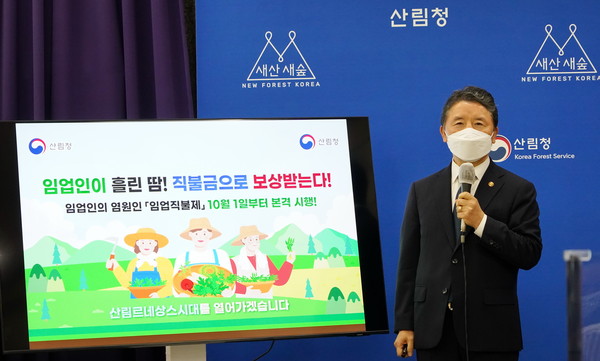Stresses Minister Nam Sung-hyun of Korea Forest Service (KFS) at an interview
“We will make all-out efforts to realizing the era of forest renaissance through advanced country-style forest management,” said Minister Nam Sung-hyun of Korea Forest Service (KFS).
In an interview with The Korea Post media, the publisher of 3 English and 2 Korean-language news publications since 1985, Minister Nam also said, “KFS will develop a program that takes advantage of the characteristics of our country and provide it to forest road users. By doing so, it will become a world famous East-West Trail, which will greatly contribute to attracting foreign tourists.”
Following are the excerpts from an interview with Minister Nam Sung-hyun of Korea Forest Service (KFS).

Question: You expressed your will to open the era of forest renaissance. Could you please explain how to implement it?
Answer: Since my inauguration on May 13, I have been working hard to enact the vision of “Realizing the era of forest renaissance through advanced country-style forest management.”
The ‘keyword for forest management in advanced countries’ is to maximize the economic, environmental, and socio-cultural functions of forests through science-based forest management.
Nowadays, when I have the opportunity to communicate with various opinion leaders, reporters, and students, I ask them if they think of forests as nature or resources.
Of course, the forest is nature, but at the same time it is resources with great potential value.
From this point of view, the forests to be preserved should be thoroughly preserved, and other forests should be utilized sustainably to find the optimal balance and value of forests, which are nature and resources, economy and environment, public goods and private goods.
Through this process, the people can enjoy the welfare that can be enjoyed in the forest as much as possible, and the forestry person who manages the forest can guarantee the income and manage the forest with a good reputation. In other words, I want to make the era of the forest renaissance.

Q: Please explain the prospects such as the implementation and effect of forestry direct payment.
A: About 65% (4.11 million hectares) of forests are private forests, providing various public functions, but forestry is subject to various regulations, so about 79% of farm households and about 73% of fishery households earn low income. Therefore, compensation is needed for this.
As a result of continuous efforts since 2005 to promote the public interest function of forestry and forests and to stabilize the income of forestry workers, the Forestry Direct Payment Act was enacted on Nov. 30, 2021 and is expected to be implemented on Oct. 1, 2022.
Currently, the first application was received from July 1 to Aug.1 for the forestry direct payment in 2022, and an additional application was received from Sept.7 to Oct.7.
The applicants will be paid from November after investigating the application details and verifying the qualification.
The forestry direct payment is subject to payment if the producing area for forest product production and forestry business are registered with the forestry management company by Sept. 30, 2022, and the qualifications for engagement, sales (or forestry performance), income, etc. are met.
About 28,000 forestry workers will benefit from the forestry direct payment system, which is expected to increase about 1.67 million won per household and 4.5% of the forestry household income.
In the future, the forestry direct payment system will be operated to provide stable income for forestry workers and to contribute to the improvement of public service functions through forestry forest for the public.

Q: What are the support measures for forestry management?
A: Korea Forest Service is implementing various support policies for forestry management, such as forestry direct payment system, loans, production base creation, distribution and processing facility support, and market support to increase the income of forest households.
The 「Forestry Direct Payment Act」 was enacted in November 2021 to enhance the public function of forestry and forest and to stabilize the income of forestry workers.
KFS received applications in July this year and paid for the first time.
It also supports the expansion of production infrastructure so that forest products can be produced in a larger and more modern way.
In order to process and distribute forest products produced by forestry workers, KFS is supporting subsidized businesses such as forest products distribution center and processing facilities.
In addition, K-Forest Food and Geographical Indication System are being operated to promote the consumption of excellent forest products every year.
Considering the specificity of forest management, KFS is promoting financial support for forestry workers through long-term low-interest loans and tax reforms for professional forestry workers, and are pursuing income stabilization projects such as forest product disaster insurance.
In addition, in order to meet the diverse educational needs of the villagers and forestry workers, we are expanding specialized educational institutions to 42 by 2022 and supporting systematic education and consulting such as field-oriented forest management guidance and agency management system of professional managers.
In the future, we plan to implement various forestry support policies to revitalize and stabilize income of forestry workers.
Q: What is the support of forestry management according to the change of mountain area policy?
A: Mountain areas have various demands such as environmental resources to cope with climate crisis, forestry resources for wood production, and role as land resources for industrial activities.
KFS plans to thoroughly preserve the forests to be preserved and expand support for forestry workers so that economic forestry can be realized in the mountains for forestry management.
In order to revitalize forestry management, we are considering the adjustment of the current mountain area.
Currently, mountain area for forestry, which is used by forestry workers, belongs to the mountain area for preservation. We plan to improve the mountain management system so that forestry management becomes the main purpose through rational adjustment.
In addition, since this year, we have been operating the TF for advanced regulation of mountain areas in which related professional organizations and forestry workers participate. We are also continuously improving the system by listening to the voice of the field through meetings with forestry organizations.
In August, the Mountain Area Management Act was amended to allow forestry workers to install agricultural water development equipment, which is necessary for the cultivation of forest products.
In addition, KFS is promoting legislation to improve the difficulties of the forestry field by expanding the cultivation area for garden trees in the mountain area from 30,000 square meters to 50,000 square meters to support the scale.
In the future, we will promote the improvement of the system so that the preservation and utilization of the mountain area can be reasonably harmonized and the management of the mountain area can be experienced by the forestry people.

Q: What are the outbreaks and countermeasures of forest fires?
A: Large-scale forest fires are occurring all over the world due to the recent climate change, and Korea is becoming larger and larger due to drought and local strong winds for the first time in 50 years.
During the first half of 2002, 618 forest fires occurred, increasing 1.5 times from 405 in previous years, and 11 large forest fires occurred, rose by 15% in the case and 35% in the damage area since 1986 (72 cases).
Wildfires start with the slightest carelessness of people in general. In addition, prevention of forest fires is very important, so the top priority of forest fire prevention policy is forest fire prevention.
In Korea, 481 forest fires occur annually, with 34% of incidents, 27% of incineration of waste and agricultural byproducts, and 5% of forest fires caused by building fires. Wildfires caused by human carelessness account for 66%.
Korea Forest Service will push for real-time accurate situation judgment, response, and putting out forest fires by utilizing the control of entry through big data analysis, closure of trails, forest fire risk forecasting, forest fire situation control, and forest fire spread prediction system using the latest ICT science and technology.
Through a thorough analysis of large-scale forest fires that occurred this year, we will make every effort to respond to forest fires by expanding forest fire fighting helicopters (super helicopters etc.), specialized fire fighting personnel (forest fire special fire fighting team) and high-performance fire fighting vehicles.
As mentioned earlier, forest fires occur throughout the year and are becoming larger and larger, and can quickly spread to residential areas and major facilities, resulting in personal injury and property damage.
As Minister of KFS, in case of evaluating this year's wildfires, fortunately there were no casualties and the country's major facilities such as nuclear power plants and gas facilities were safely protected.
We would like to express our sadness to the victims of the damage caused by wild fires and we will do our best to recover.
We would like to take this opportunity to thank the related organizations and volunteers who have concentrated their capabilities together to extinguish forest fires, and the firemen who demonstrated their talents.

Q: What are the outbreaks and countermeasures of forest diseases and pests?
A: As of 2021, 380,000 trees were damaged by pine wilt disease and other forest diseases and pests damaged 61,000 ha of forest.
We are striving to prevent the spread of damage by strengthening our activities in advance and responding promptly to forest pest damage.
Through the operation of a forest disease and pest surveillance team (1,500 people) and aerial surveillance using helicopters, thorough surveillance in the air and on the ground is being pursued.
We have built a scientific-based forecasting system to minimize the blind spot.
About 520,000 ha/year of unmanned aerial vehicle (drone) surveillance has been operated, 3,822 electronic surveillance boxes were installed, and 320 organizations (affiliates, local governments, etc.) are operating a QR code-based dead tree history management system.
We are making every effort to improve the pest control effect and reduce damage by promoting control activities tailored to each type of forest pests.
In order to prevent the spread of pine wilt disease, we are taking all-out measures and expanding clean areas.
We are making efforts to minimize damage with customized control according to each degree of damage from pine wilt nematode disease (level 5, mild to severe), and improve the quality of the pest control project by controlling all damaged trees and strengthening on-site inspections.
We will continue to promote the control of major forest pests in consideration of the life history and reduce the damage to manageable levels.
Simultaneous occurrence of agricultural and forestry areas and foreign and sudden pests will be dealt with in a timely manner and control effect will be enhanced by strengthening cooperation with related organizations (Rural Development Administration, local governments, etc.).
In order to maintain and manage a healthy and safe green environment in the living area, we are continuously nurturing professional manpower such as tree doctors.
The tree doctor system (diagnosis, prescription, prevention, and treatment) has been implemented since 2018 to be performed only in tree hospitals.
Q: What is forest welfare and how is daily recovery support through forest welfare?
A: ‘Forest welfare’ means ‘forest culture and recreation, forest education and forest healing, etc., providing various forest welfare services to the people.
A total of 973 forest welfare facilities, including recreational forests, infant forest experience parks, healing forests and forest parks, provide a variety of forest welfare services. Last year, a total of 19 million people used them.
As the demand for forests for healthy leisure increases due to COVID-19 pandemic, we expand forest welfare services tailored to each life cycle and expand forest welfare infrastructure such as forest campsites, natural recreation forests, and healing forests, thereby promoting the 'sociocultural function of forests.'
In particular, for a healthy daily recovery from the prolonged COVID-19, about 5,500 medical staff and quarantine personnel and about 10,000 students who were unable to attend school due to COVID-19 are supported to experience the forest healing program.
A total of 695 smart gardens (modular indoor gardens) have been installed in 90 medical institutions, 217 public facilities, and 388 industrial complex companies to help people recover from emotional and fatigue through green infrastructure.
In the future, we plan to expand forest healing programs for firefighters and social welfare workers who are working for the public health and safety, and to expand urban forests and smart gardens so that they can get closer to the forests in daily life.
In addition, this year, we are striving to create a society where everyone is happy by providing the 'Forest Welfare Service Voucher (Titled the Forest Welfare Voucher)' to experience forest welfare services to 50,000 socially disadvantaged and marginalized people who are unable to benefit from forest welfare services due to social and economic conditions.

Q: It is said that the East-West Trail will be built in our country and the pilgrimage route to Santiago will not be envied.
A: KFS announced the 『2nd Basic Plan for Creation and Management of Forest Roads』 in June. The 'East-West Trail' project was selected as a key project to be promoted for the next five years. Therefore, it is planned to be built by 2026 and the whole section will be opened in 2027.
The East-West Trail is a long-distance trail with a total length of 849 km from Anmyeondo in Taean-gun, Chungcheongnam-do to Uljin-gun in Gyeongsangbuk-do.
From the west, the trail will pass through five metropolitan municipalities such as Chungcheongnam-do, Sejong Special Self-Governing Province, Daejeon Metropolitan City, Chungcheongbuk-do and Gyeongsangbuk-do.
In detail, it will pass through 21 cities and counties, 87 eup and myeon, and 239 small villages.
You can see various historical and cultural resources of Korea from the East-West Trail.
In Chungcheongnam-do, there are many Buddhist monuments such as Seosan Mae Samjon Buddhist statue, Boonwonsaji, Sangari Maitreya, Namyun-gun tomb, Wonhyoam site and Baekje ruins.
Sejong City has excellent views of the Geum River, which is seen from the Mabong Trail, Daejeon City has a mountain fortress, and Daecheong Lake has excellent waterfront scenery.
In Chungcheongbuk-do, there are Samnyeonsanseong Fortress in the Three Kingdoms period, the village where King Sejo stayed, the Maltese where King Taejo Wang Geon crossed. In Gyeongsangbuk-do, there are Sibiryeong-gil and Geumgang Pine Forest.
In addition, through the East-West Trail, we can directly experience Korea's outstanding forest resources.
In Taean-gun, Chungcheongnam-do, there is Anmyeondo pine forest, which has been specially managed by the royal family since the Goryeo Dynasty.
In the middle part of Boeun-gun, Chungcheongbuk-do, there is a pine tree path of Songnisan Mountain.
In Uljin-gun, Gyeongsangbuk-do, there is the largest Geumgang pine community in Korea.
The east-west trail is planned to be constructed in 55 sections, and one section becomes a one-day course.
The route will be marked as the five sections -- very easy, easy, normal, difficult, very difficult -- so that it can be selected according to the characteristics of the user.
In order for the forest road to continue, cooperation with mountain villages is needed.
In the place where the forest road users come down to the mountain village, we have a plan to provide lodging service in mountain villages, local specialty products, and lunch boxes to the mountain visitors to contribute to the revitalization of the mountain village economy.
If we develop a program that takes advantage of the characteristics of our country and provide it to forest road users, it will become a world famous trail.
We will also contribute to attracting foreign tourists through the East-West Trail.

